Opinions from Others.
Page 19

If you've noticed an error in this article please click here to report it so we can fix it.
The Design of the Omnitractor.
The Editor, THE COMMERCIAL MOTOR.
[1611] Sir,—I should like to make a few remarks in reply to Mr. F. Page's letter (No. 1602) in THE COMMERCIAL MOTOR of 23rd March.
(a) Road Wheels.—It has been for a long time aadebatable point if the present form of construction of casting spokes with the hub is the best method. Many engineers are inclined to think it is not. Motorwagon builders have certainly found it not advisable -to do so, as the spokes will not stand the vibration and soon become broken. This more or less applies to traction engines, internal-combustion and steam. American engineers do not cast the spokes into the hub, but make all-built-up wheels, and if these spokes are made a good fit there is no reason why they should not stand a large amount of wear. The designers of the Omnitractor point out that they are easily renewed, but that is not so with spokes east with the hub, and if Mr. Page has had any practical experience in repairing wheels of the type he advocates he will know this is perfectly true. (b) Road Gearing.—Mr. Page is quite correct in saying spur gearing has always proved superior to bevels and has been adopted on all traction-engine designs, but when he goes on to say that gear rings bolted to tee rings have always failed this is far from being correct. The reason why the drive is not fitted on the road wheels as in the Omnitractor is that the differential gear arrangements are not so easily placed. This can be more easily arranged perhaps OD the internalcombustion than on the steam tractor, although many manufacturers of steams tractors are fitting the differential on the third-motion shaft, and fitting the double drive on both wheels. I know several firms bolting gear rings on to the road wheels, and, if you can protect them from dirt, this system is by far the best method of transmission ever put on to traction engines or motor lorries. I cannot in this letter enumerate all its good points. Why-have Daimler, Clayton and Shuttleworths, and Fowlers fitted this type of gearing to their oil-traction engines? Why have Burford, British Berna and Jeffery fitted this method of gearing to their motor lorries, not forgetting the many American manufacturers fitting the same system, both to steam and internal-bombustion machines ? Are all these wrongly designed; I know traction engines, built over 30 years ago, fitted with gear rings on tee rings, and these are running still with the same gearing, although new boilers have been fitted. The reasons why the present traction gearing is so much in use are : 04) because it is more convenient in designing, (2) only one spur gearing on axle. is required, (3) the placing of differential is much easier.
I am afraid this letter is already too long to go into further details, but I should like to remind Mr. Page that he must not forget that wear takes place in the hind-axle bearings and third-motion bearings, and that this tends to bring the gears too deep, causing very much noise and annoyance when travelling on hard roads. In Mr. Page's method of transmission, the spokes have to transmit all the power of the engine through them, but this is not so in the gearing as fitted on the Omnitractor. I must give a word of praise for the designers of the Omnitractor in adopting this system of final transmission. I prefer this method above all other systems.
(e) Springs.--These should be fitted to all traction engines for farm work and also for road work. The reason why they are not fitted on agricultural machinery is on account of the expense.—Yours faithfully,
" ENGINEER IP






















